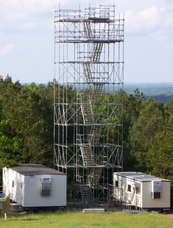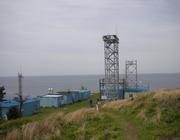
The Tropospheric Oxidation Capacity Research Group
Biosphere-Atmosphere-Human Interactions
3216 Croul Hall Irvine CA 92627 (email)

First direct measurements of formaldehyde flux via eddy covariance: implications for missing in-canopy formaldehyde sources
Journal:
Atmospheric Chemistry and PhysicsVolume Number:
11Issue Number:
20Pages:
10565-10578Abstract:
We report the first observations of formaldehyde (HCHO) flux measured via eddy covariance, as well as HCHO concentrations and gradients, as observed by the Madison Fiber Laser-Induced Fluorescence Instrument during the BEACHON-ROCS 2010 campaign in a rural, Ponderosa Pine forest northwest of Colorado Springs, CO. A median noon upward flux of similar to 80 mu g m(-2) h(-1) (similar to 24 ppt(v) m s(-1)) was observed with a noon range of 37 to 131 mu g m(-2) h(-1). Enclosure experiments were performed to determine the HCHO branch (3.5 mu g m(-2) h(-1)) and soil (7.3 mu g m(-2) h(-1)) direct emission rates in the canopy. A zero-dimensional canopy box model, used to determine the apportionment of HCHO source and sink contributions to the flux, underpredicted the observed HCHO flux by a factor of 6. Simulated increases in concentrations of species similar to monoterpenes resulted in poor agreement with measurements, while simulated increases in direct HCHO emissions and/or concentrations of species similar to 2-methyl-3-buten-2-ol best improved model/measurement agreement. Given the typical diurnal variability of these BVOC emissions and direct HCHO emissions, this suggests that the source of the missing flux is a process with both a strong temperature and radiation dependence.
Notes:
Times Cited: 2
Related External URL:
<Go to ISI>://WOS:000296593000017- Citation:
- DiGangi, JP, Boyle ES, Karl T, Harley P, Turnipseed A, Kim S, Cantrell C, Maudlin, R. L. III, Zheng W, Flocke F et al.. 2011. First direct measurements of formaldehyde flux via eddy covariance: implications for missing in-canopy formaldehyde sources. Atmospheric Chemistry and Physics. 11(20):10565-10578.

